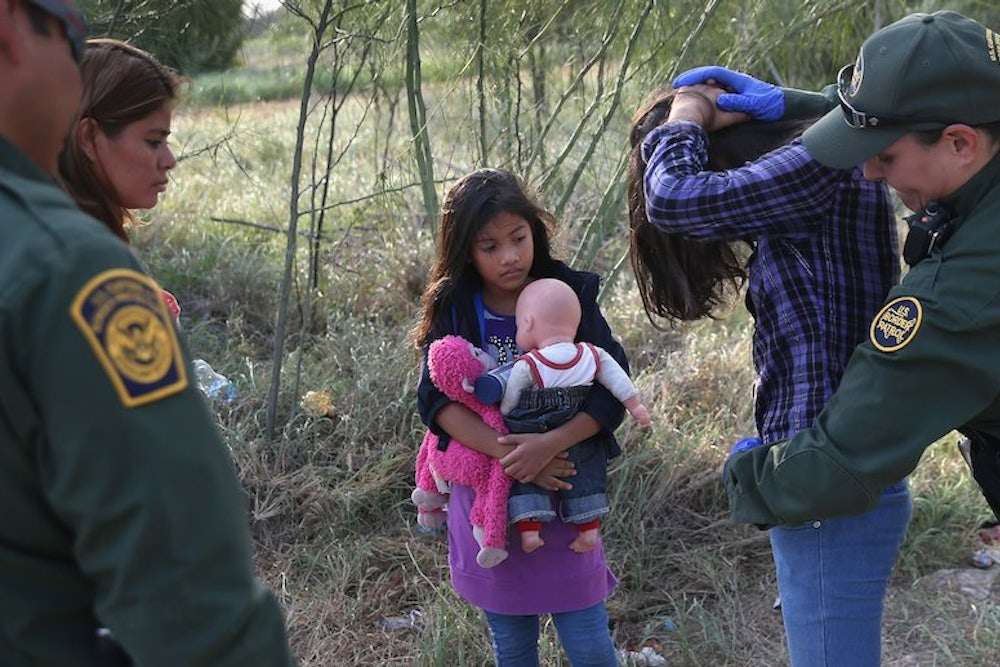Tall tales have always sprung from Texas, but the last few months have seen an uptick in their production. Beholding the procession of unaccompanied minors and young families arriving in the United States from Central America, Republican Representative Louie Gohmert, whose district is closer to Little Rock than the Rio Grande, likened the migrants to the Allied forces coming ashore at Normandy. Rick Perry, who has deployed 1,000 National Guardsmen to bolster the already sizeable law enforcement presence, dubbed the borderlands a “battlefield.” Measured by boots on the ground, that may be true, but in this case the other side lacks the element of surprise and has a habit of turning itself in. A war zone, it is not.
The Border Crisis Is Complicated. The Moral Response Is Clear.
The U.S.-Mexico border stretches across more than 1,900 miles, but the traffic of migrants across it is hardly uniform. Nearly three-quarters of the unaccompanied minors and families have come in via the Lower Rio Grande Valley, a stretch of south Texas that runs a twisty 316 river miles from the Gulf of Mexico to Falcon Reservoir in Zapata County. And the true parameters of the surge are narrower still. The vast majority of those crossings happen near the mid-sized Mexican cities of Reynosa and Matamoros, in spots that provide both cover for the Mexican smugglers (who facilitate the trips) and easy road access for the immigrants. Within that confined area, much of the attention of Border Patrol, Texas state law enforcement, and now the National Guard has been directed at a single peninsula on the U.S. side known as Rincon Village.
“If you listen for radio traffic in the Rincon Village area, it’s amazing,” Border Patrol Agent Albert Spratte, a union sergeant-at-arms, told me at the height of the crossings in June. “It’s, OK, we need two buses. OK, some vans. In that area, over the night, it’s probably several hundred or more.” Upon reaching U.S. soil, most of these women and children surrender to the first person in uniform they see. Managing the stream of migrants from Central America from a security standpoint seems to call less for overwhelming force than for running an efficient taxi service.
Traumatized women and children aren’t the only things crossing the Rio Grande Valley, of course. The neighboring Mexican state of Tamaulipas has been plagued by violence, especially since the Zetas split from the Gulf Cartel in 2010, and its drugs, criminals, and, every so often, gunfire spill over into Texas. (Law enforcement officials I spoke to warned that the cartels would use the migrant surge as a distraction to sneak across more nefarious persons and products.) But even before Perry called up the National Guard, border security was extremely robust by historical standards. There are now 3,234 Border Patrol agents in the Rio Grande Valley, nearly as many as manned the entire border 20 years ago. The state has augmented their ranks with troopers and game wardens and Texas Rangers and grant money for local police overtime. Travel along the river, and you find a veritable layer cake of agencies. In Anzalduas Park, a grassy recreation area upriver from Rincon Village where smugglers on jet skis zoom over to the U.S. riverbank to drop off immigrants, a dozen Texas Department of Public Safety patrol cars line the public boat ramp while big pickups from the local constable’s office patrol the shore road. At a local nature preserve farther upriver—a favorite of quail, bobcats, butterflies, and migrant men looking to evade capture—ground sensors and video equipment track furtive movements and Border Patrol helicopters occasionally circle overhead.
In Rincon Village itself, arriving migrants walk up a dusty road to find Border Patrol ATVs and SUVs crisscrossing the area, which is almost entirely owned by the U.S. Fish & Wildlife Service and closed to visitors. Lorenzo Anzaldua Jr., whose family members own the peninsula’s last private property, has become the area’s emissary to the media. I spent some time with him on his aunt’s plot in early August.
Anzaldua is more Ted Nugent than Cesar Chavez. He speaks fluent Spanish but has never set foot on the other side of the Rio Grande and is sure the immigration surge is President Obama’s fault. He insists on calling border crossers “wetbacks” and says he’d shoot to kill if he felt threatened by a drug trafficker. (He carries a shotgun to protect himself against cougars “and what not.”) Anzaldua supports the Border Patrol, he says, but the security buildup has rubbed him the wrong way. He comes out to the property to commune with his late father and gets interrupted by frequent visits from law enforcement. “You ever seen ‘Dukes of Hazzard?’ ” he asked. “The Border Patrol, they’re like Boss Hogg.”
The National Guard is due to arrive soon, and Anzaldua tells me that he has recently been contacted by a right-wing militia looking to join the fray. “If I see it’s too dangerous, I might not come down anymore,” he says. “Some joker is going to pull an M-16.”
“Can you imagine Border Patrol, National Guard, and militia here together?” one of his nephews, who is sitting with us, asks.
Anzaldua shakes his head. “And you know who the enemy is? Little six-year-old kids.”
